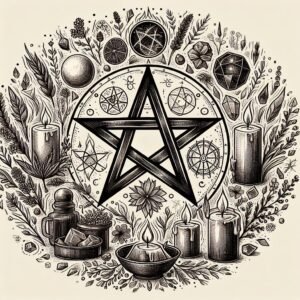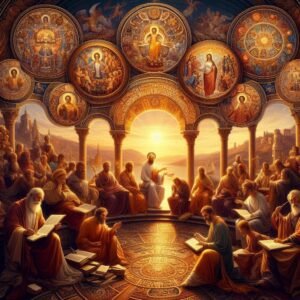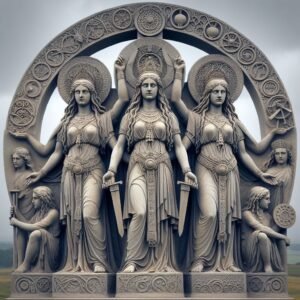
The Tower card in is one of the most striking and impactful cards in the Major Arcana, often representing significant change, upheaval, and revelation. It depicts a tower struck by lightning, with figures falling from it, symbolizing the sudden, sometimes shocking transformations that life can bring.
The Tower Card, known as the 16th trump or Major Arcana card in most Italian-suited tarot decks, has a rich history that dates back to the 15th century. Its origins are deeply rooted in medieval iconography and early printed decks, which often featured varied names and designs for this card. The Belgian Tarot, for instance, depicted a tree struck by lightning, while the 17th-century Tarot of Jacques Viéville showed a tree being struck by lightning. The Tarot of Marseilles, a standard pattern for tarot cards in the 17th century, merged these concepts into the familiar image of a burning tower struck by lightning, with people falling from it. This imagery is thought to represent sudden, disruptive revelation, and potentially destructive change.
The symbolism of the Tower Card is complex, with interpretations ranging from danger and crisis to higher learning and liberation. It is associated with the planet Mars, symbolizing aggressive force and upheaval. The card’s design in the Rider-Waite deck, created in the early 20th century by Pamela Colman Smith under the direction of Arthur Edward Waite, features small tongues of fire in the shape of Hebrew yod letters, replacing the balls seen in the Tarot of Marseilles. This design choice reflects a blend of Kabbalistic and alchemical symbolism, indicating transformative spiritual force.
The Tower Card’s introduction to the tarot deck is not attributed to a single individual but rather to the evolution of tarot as a tool for divination and reflection. The creators of early tarot decks drew from various cultural and symbolic references, including biblical stories like the Tower of Babel and the Harrowing of Hell, as well as classical myths and medieval dramas. These diverse influences reflect the card’s multifaceted nature and its ability to convey a spectrum of meanings depending on the context of the reading.
The Tower of Babel
The Tower card has been associated with the biblical Tower of Babel, which is an allegory for the consequences of human pride and arrogance. The story of the Tower of Babel tells of humanity’s attempt to build a tower high enough to reach the heavens, which was seen as an act of hubris against the divine. In response, God confounded their speech and scattered them across the earth, effectively halting their progress.
This narrative resonates with the imagery of the Tarot’s Tower card, which represents sudden upheaval, the breakdown of structures, and the fall from grace due to overweening pride. The card serves as a cautionary tale about the dangers of overreaching and the inevitable downfall that comes with it. It symbolizes the punishment of arrogance and the failure that can result from presumption and ostentation. In a reading, The Tower can be a warning to remain humble and avoid the pitfalls of vanity, reminding us that structures built on shaky foundations—whether they be literal towers, relationships, beliefs, or ambitions—are vulnerable to collapse.
The card’s connection to the Tower of Babel reinforces the idea that spiritual or personal growth should not be driven by ego or vanity, but rather by a genuine desire for enlightenment and understanding. The Tower card, therefore, encapsulates a powerful message about the importance of humility and the transient nature of material and worldly achievements. It invites reflection on the foundations upon which we build our lives and the motivations behind our ambitions, urging a path of self-awareness and respect for the natural order.
The Harrowing of Hell
The Tower card is often associated with chaos, sudden upheaval, and the breaking down of existing structures. This imagery can be linked to the Harrowing of Hell, a Christian belief that describes Christ’s descent into Hell between his crucifixion and resurrection.
During this time, it is said that Christ triumphed over the powers of Hell and granted salvation to the righteous who had died before his coming. The Tower’s depiction of a structure being struck down resonates with the idea of Jesus disrupting the foundations of Hell, symbolizing a profound change and liberation from bondage.
In some interpretations of the Tarot, the Tower is thought to represent the moment of enlightenment or revelation that comes with such a dramatic event, akin to the spiritual awakening that the Harrowing of Hell represents for believers. The connection between the two concepts lies in the shared themes of upheaval leading to renewal and the idea that destruction of the old makes way for rebirth and new beginnings.
The Harrowing of Hell is a profound concept in Christian theology, encapsulating the events between the Crucifixion and the Resurrection of Jesus Christ. It is during this interlude, known as the Descent into Hell, that Christ is said to have proclaimed victory over death and offered salvation to the souls of the righteous who had passed away before His earthly ministry.
This event is not explicitly detailed in the canonical scriptures but is alluded to in passages such as 1 Peter 4:6, which speaks of the gospel being preached to those who are dead, suggesting a retroactive redemption for the departed. The Apostles’ Creed and the Athanasian Creed, two foundational Christian statements of faith, reference Jesus’ descent into the underworld, though they stop short of describing the liberation of souls.
The Harrowing of Hell has been depicted in various forms of art and literature, often illustrating Christ breaking the gates of Hell and leading the captives to freedom. This imagery symbolizes the ultimate triumph over sin and death, a cornerstone of Christian soteriology. The event is commemorated in the liturgical calendar on Holy Saturday, marking a day of quiet anticipation of the Resurrection. Theological interpretations of the Harrowing vary among different Christian denominations, with some viewing it as a literal event and others as a more metaphorical or spiritual victory.
The concept also appears in apocryphal texts, such as the Gospel of Nicodemus, which provide more elaborate accounts of Christ’s descent. These non-canonical stories have influenced Christian thought and tradition, even if they are not considered authoritative scripture. The Harrowing of Hell is also a subject that has been explored in theological writings and sermons throughout the centuries, each adding layers of understanding to this enigmatic episode of Christ’s work.
In cultural expressions, the Harrowing of Hell has inspired artists, poets, and playwrights, particularly during the Middle Ages. It has been a theme in mystery plays, which were among the earliest forms of English drama, and in the visual arts, it is often represented by the motif of the Anastasis, especially in Eastern Orthodox iconography. The term “harrowing” itself, in Old English and Middle English, conveys the action of Christ as harrowing or plundering Hell, a vivid depiction of His victory.
The Harrowing of Hell, therefore, is not just a theological assertion but a narrative that has shaped Christian imagination and discourse. It encapsulates the hope of redemption and the belief in a power that conquers all bonds, offering a message of liberation that resonates beyond its scriptural origins.
The imagery of the Tower Card
Originally, the imagery of the Tower Card varied significantly across different decks, with some depicting a tree struck by lightning and others showing a tower being destroyed, which could be interpreted as a reference to the biblical Tower of Babel or the Harrowing of Hell. Historically, the card was associated with sudden, disruptive revelation and potentially destructive change.
In contrast, modern interpretations of the Tower Card often focus on the potential for personal transformation and liberation that can come from such sudden changes. The Rider–Waite deck, for example, depicts the top of the tower as a crown, symbolizing materialistic thoughts being brought down, suggesting a theme of liberation from materialistic constraints.
The Tower is also associated with the planet Mars, which adds a layer of astrological meaning to the card, linking it to themes of war, aggression, and conflict, but also courage and assertiveness. Over time, the Tower Card has evolved from a symbol of cautionary tales and divine retribution to a complex emblem of upheaval that can lead to self-awareness and rebuilding on a more solid foundation.
The card suggests that structures, beliefs, or situations built on shaky foundations may be destroyed to make way for new growth. It’s a card of awakening, where the destruction of the old invites the opportunity for a fresh perspective and a clearer understanding of one’s path. Despite its seemingly daunting imagery, The Tower ultimately serves as a reminder that from chaos can come clarity, and from endings can come new beginnings.
Interpreting the Tower card
The Tower card is often associated with dramatic upheaval and the sudden collapse of structures or beliefs. When it appears in a reading, it can signify that the querent is experiencing, or is about to experience, a profound transformation that may feel chaotic or destructive.
This card can symbolize the collapse of the ego or long-held beliefs, particularly if they have been built upon shaky or false premises. The imagery of the Tower—struck by lightning and crumbling—suggests a sudden revelation or shock that disrupts the very foundation of someone’s understanding or sense of self. It is a powerful metaphor for an existential crisis, where the individual’s world-view is challenged, and they must confront the reality that their previous beliefs may not have been as solid as they thought.
This card does not necessarily predict doom; rather, it indicates a necessary process of deconstruction that precedes personal growth and the building of a more authentic self. The destruction of the Tower paves the way for a new, more stable foundation to be established, one that is in alignment with the individual’s true self and the universe’s unpredictable nature. It’s a reminder that sometimes, things need to fall apart to make room for something better and more truthful. The Tower’s message is ultimately one of liberation from false constructs, encouraging a fresh start built on clarity and enlightenment.
This card can evoke fear, as it represents the unknown and the possibility of loss. However, it also embodies the potential for liberation from outdated modes of thinking and being. The imagery of the Tower—struck by lightning and aflame, with figures falling from it—suggests a cataclysmic event that disrupts the very foundations of one’s life. Yet, it is precisely through such disruption that one has the opportunity to rebuild more authentically.
The Tower card’s association with “kill or cure” events speaks to its dual nature. On one hand, it can represent the destruction of illusions, the shattering of false beliefs, and the painful but necessary process of letting go. On the other hand, it can signify the strengthening of one’s convictions, the forging of a more resilient self through the trials faced.
The adversaries that appear when the Tower card is in play are not just external forces; they can also be internal, representing our fears, doubts, and resistance to change. These adversaries challenge us to confront what we have avoided and to question what we have accepted without scrutiny.
When the Tower card appears in a reading, it is a call to brace oneself for impact, to prepare for the potential of radical transformation. It is a reminder that while structures may crumble, the essence of who we are can emerge stronger and clearer.
The card encourages one to examine the foundations of their beliefs and to consider what is truly serving their highest good. It is an invitation to embrace change, however daunting it may seem, and to recognize that in the aftermath of the Tower’s fall, there is space to create something new and more aligned with one’s true self.
In essence, the Tower card is a harbinger of necessary change. It challenges the querent to release outdated and limiting patterns, to face adversaries with courage, and to understand that what may seem like destruction is often the universe’s way of clearing a path for new growth.
Whether one’s tower of belief is strengthened or collapses entirely depends on their ability to adapt, learn, and find meaning in the chaos. The Tower card does not promise an easy journey, but it does assure that the journey will be significant, leading to greater self-awareness and authenticity. It is a testament to the resilience of the human spirit and the transformative power of life’s most challenging moments.
Subscribe to our post updates - Don't miss a thing!!








